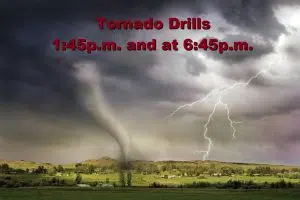 Tornado Preparedness: A Guide to Staying Safe During Severe Weather
Tornado Preparedness: A Guide to Staying Safe During Severe Weather
As Severe Weather Awareness Week unfolds, understanding the dangers of tornadoes and taking necessary precautions can be life-saving.
Every year in the United States, hundreds of lives are lost, and thousands of people are injured due to severe weather events.
These dangerous weather phenomena can vary from violent tornadoes to crippling winter storms.
While there is no way to stop these events from occurring, being prepared and taking necessary precautions can significantly enhance safety and survival during such incidents.
There will be Tornado Drills April 20th at 1:45 in the afternoon and again at 6:45 in the evening within the city of Fergus Falls, where the Sirens will sound throughout the city.
This article, coinciding with Severe Weather Awareness Week, aims to educate readers on the dangers of tornadoes and provide essential safety tips for preparedness.
A tornado is a violently rotating column of air that extends from the base of a thunderstorm down to the ground.
These powerful storms can cause widespread destruction, uprooting trees, and turning debris into deadly projectiles.
Tornadoes can occur at any time, day or night, and throughout the year.
While they are most common in the Central Plains and the southeastern United States, they have been reported in all 50 states.
As many may or may not know, 104 years ago a tornado blew through Fergus Falls on the afternoon of Sunday, June 22, 1919, at 4:45 in the afternoon.
The population of Fergus Falls at the time was about 12,000.
The town was struck by a F5 tornado which, almost in an instant, razed 228 houses, and killed 57 people.
Understanding the difference between a Tornado Watch and a Tornado Warning is crucial for taking appropriate action:
- Tornado Watch: Be prepared! Tornadoes are possible in and near the watch area. Review and discuss your emergency plans, check supplies, and ensure your safe room is ready. Be prepared to act quickly if a warning is issued or you suspect a tornado is approaching. Early action saves lives!
- Tornado Warning: Take action! A tornado has been sighted or indicated by weather radar. There is imminent danger to life and property. Move to an interior room on the lowest floor of a sturdy building, avoiding windows. If you are in a mobile home, a vehicle, or outdoors, seek the closest substantial shelter and protect yourself from flying debris.
Preparedness is vital for staying safe and minimizing impacts:
- Be Weather-Ready: Regularly check forecasts to assess your risk for tornadoes. Listen to local news or a NOAA Weather Radio to stay informed about tornado watches and warnings.
- Understand Community Warning Systems: Familiarize yourself with your community’s warning systems, which may include outdoor sirens, media, or smart phones.
- Create a Communications Plan: Develop a family plan that includes an emergency meeting place and related information. Identify a nearby safe building for those living in mobile homes or homes without a basement.
- Choose a Safe Room: Select a safe room in your home, such as a basement, storm cellar, or an interior room on the lowest floor without windows.
- Reinforce Your Home: Consider reinforcing your safe room for better protection. The Federal Emergency Management Agency (FEMA) provides plans for reinforcing interior rooms on their website.
- Help Your Neighbor: Encourage loved ones to prepare for tornadoes, and consider taking CPR training to assist in case of injuries.
When a tornado strikes, acting quickly is essential for staying safe and minimizing impacts.
Stay informed, follow your tornado drills, and seek shelter in a sturdy building.
In the aftermath of a tornado, continue monitoring updates, assess damage, and help neighbors if needed.
Remember, being prepared and staying vigilant can make all the difference during severe weather events.